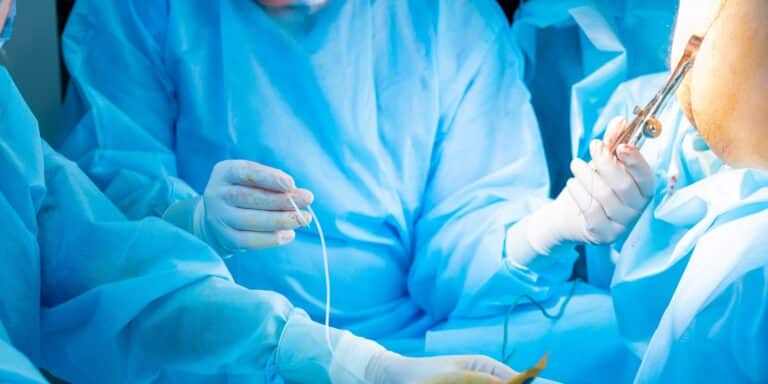
Michael Joe Cini
12th April 2023
LA Researchers Create Rapid Gelatin-based Sealant for Surgical Operations
In surgery, sealing incisions has been a major challenge for practitioners. Researchers have experimented with early gelatin-based sealants in the recent past, which demonstrated moderate success. Recently, researchers at the Terasaki Institute for Biomedical Innovation in LA, recognizing the need to improve surgical sealing materials, have developed a new hybrid sealant. Based on a combination of gelatin and caffeic acid, the new sealant has the potential to facilitate effective sealing in surgeries.
Discovering caffeic acid: How the Terasaki researchers solved the sealant puzzle
Surgical sealants and adhesives allow surgeons to re-approximate injured or incised tissues in a variety of operations, including the closure of dural flaps, anastomoses of blood vessels, intestinal anastomoses, and glueing of skin flaps. The most critical feature of a suitable surgical sealant is the ability to maintain appropriate mechanical properties – good adhesive strength, fast glueing, and appropriate flexibility – while not interfering with the natural healing process of the wound. The adhesive can break apart before the wound heals properly if it is too brittle. If it is recognized as a foreign body, it may elicit an immune reaction, causing further inflammation at the site of the injury.
The researchers at the Terasaki Institute for Biomedical Innovation in Los Angeles recognized gelatin as a suitable material for devising their new sealant. Gelatin is a mixture of polypeptides derived from the irreversible hydrolysis of collagen, the most abundant structural protein in animal cells. Collagen is found in cartilage, bone, skin, and other connective tissues, providing structural integrity and tensile strength. Before their research, gelatin had been well-documented in the literature as a valuable material for sealing surgical incisions.
However, while they are typically low-cost, biocompatible, and effective in eliciting hemostasis, existing solutions lack adhesive strength, making them brittle and prone to breaking after being put in place. To improve gelatin’s binding ability, scientists have typically added catechol, a natural molecule that binds to specific sites in the gelatin macromolecule, improving its binding ability in the body. However, gelatin has relatively few binding sites in its molecule, which limits the amount of catechol that can bind to its structure. With fewer catechol-binding sites available, only a limited degree of improvement can be attained by adding catechol to gelatin.
To solve this problem, the Terasaki Institute for Biomedical Innovation (TIBI) researchers replaced catechol with caffeic acid, a catechol-containing compound in coffee and olive oil. Caffeic acid oligomers each contain a small number of catechol units. By adding caffeic acid to gelatin, the researchers amplified the number of catechol units bonded to gelatin, improving its adhesive function.
The researchers tested the results of this modification in pigs’ lung, heart, and bladder wounds, finding superior adhesive strength, stretchiness, and the ability to form a gel rapidly when applied to a wound site. “Functionalization of gelatin with CA oligomers enables rapid formation of physical gels upon exposure to room temperature, tunes the viscosity of the gelatin-caffeic acid pre-gel solution for controllable injectability onto multiply curved tissues, and boosts the antioxidant effects of CA,” the researchers note in a February 2023 Cell Reports Physical Science paper.
The gelatin sealant is also effective at selectively adhering to tissues, binding at the tissue-sealant interface and being free of binding on the opposite face. Validation tests on the new sealant revealed significant adhesive strength despite mechanical deformation, attempts at scraping, and burst pressure experiments. The new sealant was biocompatible, further cementing its potential utility in human surgeries. Ali Khademhoseeini, Director and CEO at Terasaki Institute, said of the new sealant, “Our team has utilized manipulative and strategic chemistry to significantly improve adhesive strength and versatility in biomaterials. This creates exciting possibilities for more effective surgical wound management in the clinic.”
The perpetual search for the ideal surgical sealant
When physicians carry out surgical procedures, it is very common to make incisions into the body’s internal organs. For example, a surgeon working on removing a tumour in the cerebral cortex, the portion of the brain responsible for perception and voluntary control, will have to make an incision into the dura mater. The dura mater is the fibrous sheet that forms the outermost layer of the meninges, protecting the brain and cranial nerves. Likewise, a general surgeon carrying out open surgery on an abdominal organ may make an incision into the peritoneum or the affected organ.
And while incisions are perfectly normal during surgeries, ensuring they are adequately closed immediately after the operation is vital. Surgeons have employed several ways of closing incisions, including stitching (using sutures to close up a wound), staples, and Steri-Strips, a special adhesive tape.
Each method of sealing has its merits; for example, sealant film is synthetic and forms covalent bonds with primary amines located on tissue surfaces. First mentioned in papers published as far back as 2013, sealant film incorporates absorbable polymers with significant structural and adhesive properties and has been used to seal dura mater, prevent blood loss, and eliminate air leaks after lung resection. However, sealant films and techniques such as suturing have their issues, which have prompted researchers to find new solutions to apply in surgery.
For one, suture materials are foreign bodies implanted into human tissues, often eliciting a foreign-body reaction after some time. Other factors, such as incorrect suture selection, improper suture technique, and wound dehiscence, can also affect sutures. Air leaks have also been a significant challenge in thoracic surgeries where the lung is operated on. Lindsey Sanders and Jiro Nagatomi write in a 2021 Critical Reviews in Biomedical Engineering article, “One of the main issues sutures present is traumatic punctures to surrounding tissue from the needle, which is especially detrimental for vital organs such as liver or lung, where stopping leaks of blood and air by suturing is difficult.”
More recently, researchers have been developing surgical sealants and adhesives that would be effective, fast, and biocompatible, with collagen-based adhesives, fibrin sealants, and gelatin-based adhesives among the more popular solutions in the market today. Available surgical adhesives include cyanoacrylates, albumin and glutaraldehyde, polyethylene glycol (PEG), polyurethane, and fibrin. However, many of these sealants have met significant resistance to their full adoption, with clinicians citing issues such as extra time required for sealant preparation, increased expenses in surgical procedures, risk of fusion inhibition, and a general preference for suturing in certain procedures.
We invite you to join us in Malta later this year
At the Med-Tech World Summit on October 19-20, we’ll be assembling the brightest minds in healthcare and technology to help shape the future of medicine. This is an exciting opportunity that you won’t want to miss.




